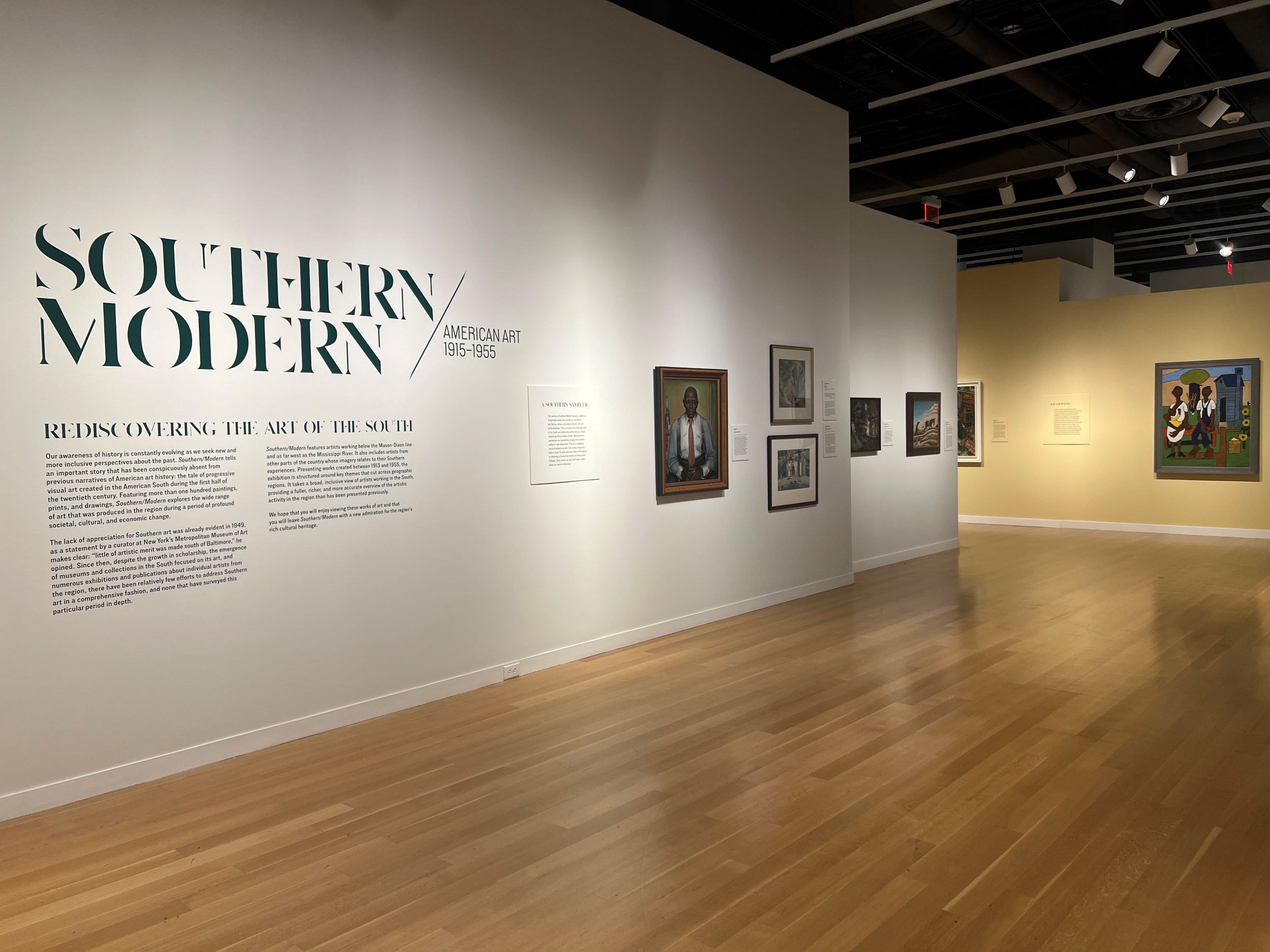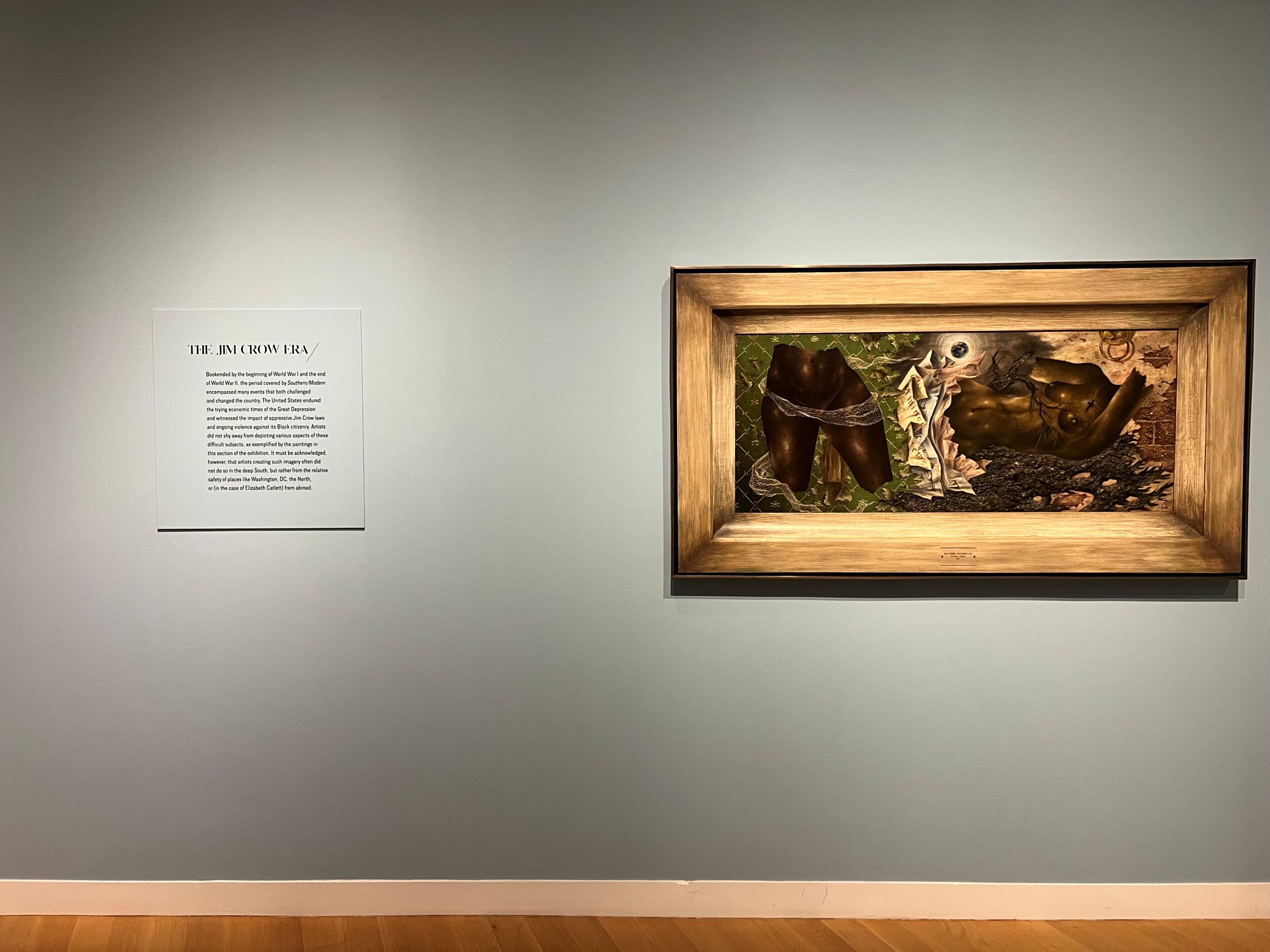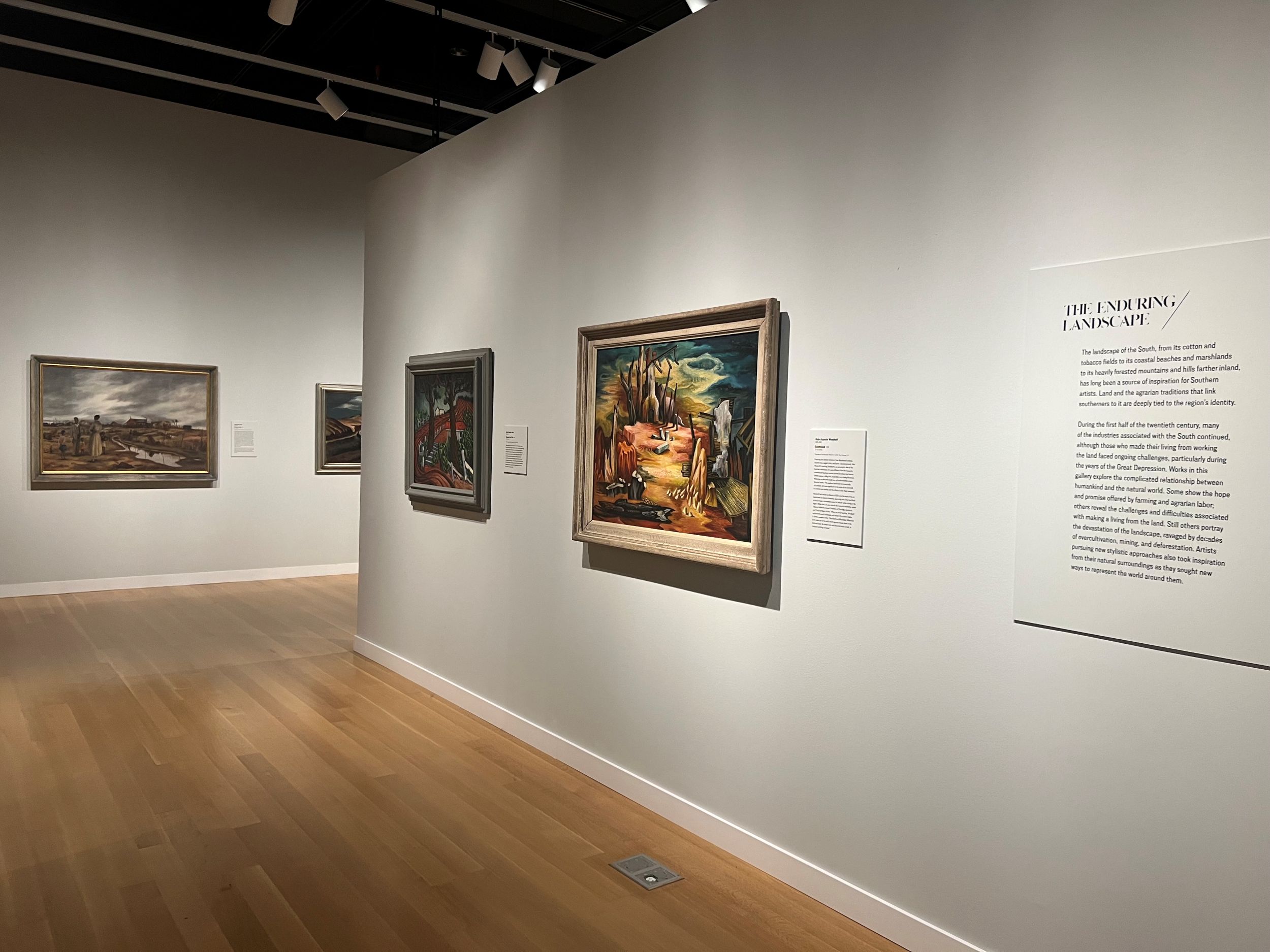Southern/Modern
PDF: Ittner, Review of Southern/Modern
Curated by: Jonathan Stuhlman, Mint Museum; and Martha R. Severens, independent scholar
Exhibition schedule: Georgia Museum of Art, Athens, June 17–December 10, 2023; Frist Art Museum, Nashville, TN, January 26–April 28, 2024; Dixon Gallery and Gardens, Memphis, TN, July 14–September 29, 2024; Mint Museum, Charlotte, NC, October 26, 2024–February 2, 2025
Exhibition catalogue: Jonathan Stuhlman and Martha R. Severens, Southern/Modern: Rediscovering Southern Art from the First Half of the Twentieth Century, exh. cat. University of North Carolina Press, in association with the Mint Museum, Charlotte, NC, 2023. 272 pp.; 196 color illus. Cloth: $65.00 (ISBN: 9781469674087)
In the spring of 2020, Panorama published a special issue dedicated to the art and visual culture of the American South, guest edited by art historian Naomi Slipp. Her opening essay, outlining the South’s long elision from accounts of American art, took its title from the words of Metropolitan Museum of Art curator Joseph Downs, who in 1949 declared that “little of artistic merit was made south of Baltimore.”1
These words also introduce Southern/Modern, a bracingly revisionist survey of art made in the South, which recently ended its four-venue tour at the Mint Museum in Charlotte, North Carolina. Joining Slipp and many other scholars in challenging the South’s long dismissal, the exhibition took on a particularly neglected passage in the art histories of the region—the early twentieth century—making the case that seeing the South as meaningfully modern might also allow it to be seen as artistically important. Both are views made possible, emphatically and repeatedly, across Southern/Modern, a survey big and bold enough, one hopes, to put the question of the South’s “artistic merit” to rest once and for all.
And survey it certainly was, in scope as well as in ambition. Comprising more than one hundred works, made by artists working in nearly all parts of the South, Southern/Modern was substantial by any measure, the scale itself a crucial argument for the region’s cultural richness. The exhibition’s curators, Jonathan Stuhlman and Martha R. Severens, were upfront about this magnitude. They announced, in the exhibition’s introductory text, their purposefully inclusive approach to everything from where the South is located (loosely bounded by the Mason-Dixon Line to the north and the Mississippi River to the west, although frequently reaching beyond these borders to places like the Ozarks) to who makes Southern art (those born in the region but also transplants and repeat visitors) and even what “modernist” art looks like (ranging from figurative American scene painting to pure abstraction). In Charlotte, the first gallery, a “sampler” of the exhibition to come, previewed this breadth visually (fig. 1). Offering visitors a glimpse of the complications, rather than tidy resolutions, that would unfold, it also functioned as a space to prepare for the complex terrain ahead.

The South that emerged in the galleries that follow is indeed complex—“a land of tremendous contradictions,” to use the phrasing of Thomas Hart Benton (1889–1975), who visited the region in the late 1920s.2 Benton’s sole work in the exhibition, Ploughing It Under (1934, reworked 1964), summarizes a dominant view of the region at the time—one rooted in the fact that the South was largely agrarian and rural for much of the period the exhibition considered (between 1913 and 1955). Picturing a Black agricultural worker walking slowly behind a mule-driven plow, Benton’s painting speaks of the South in a familiar language, taking up what the art historian Anna Arabindan-Kesson has called the “fetishized figure” of the Black sharecropper, which had by then become an icon of the South’s intertwined racial and economic orders.3 Yet, other works in the show gestured to the changes that were already threatening this order by the time Benton visited. The South’s rapid if uneven and often halting industrialization, for instance, is seen in works like Frank Hartley Anderson’s (1890–1947) Iron Furnace (c. 1934) or Roderick MacKenzie’s (1865–1941) Spirit of the Furnaces (Hydraulic Lift, Steel Mill at Birmingham) (1922). Depicting the industrializing Southern landscape from a range of perspectives—the crisp lines and neatly ordered smokestacks in Anderson’s woodcut are starkly different from the red-hot liquid metal in MacKenzie’s pastel—these works speak to Southerners’ varied reactions to the industrializing landscape, from deep anxiety to full-throated embrace. The result is a narrative of the South defined not by a unified landscape or consolidated economic system but by the set of combustible tensions that define life there: a region as inchoate and potentially explosive as the molten metal in MacKenzie’s work.
This emphasis on complexity is important, given the tendency to view the South as a (usually backward) monolith in the manner of Downs. But it is also critical because of the response that this dismissal engendered among some Southerners, who, in their eagerness to defend the region’s culture, often emphasized its sameness or excused its basis in exploitative social and environmental relations.4 In other words, the question of what a “missing” Southern modernism looked like could easily have garnered a single, simplified answer, one that might have glorified the South or covered over its violent realities.
This, however, was not the case in Southern/Modern, whose title, in its either/or formulation, acknowledged the tension between the two sides, posing questions about the possibility of their reconciliation. Could a place rife with violence and regressive mores be the birthplace of anything considered progressive? Could the Jim Crow South give rise to a modern art? These are questions prompted by works like Eldzier Cortor’s (1916–2015) Southern Souvenir No. II (c. 1948), which introduced a gallery dedicated to the Jim Crow South (fig. 2). The painting’s eerie light and fragmented Black female bodies deploy the strategies of Surrealism to depict the South as a dark, brutal alternative world. In Loïs Mailou Jones’s (1905–1998) Mob Victim (Meditation) (1944), a single Black figure gazes upward into a tree, his far-off expression so absorbing that the viewer only belatedly notices the rope binding his hands, producing a shock difficult to shake. Ultimately, as art historian Rebecca VanDiver aptly puts it in her essay in the exhibition’s accompanying catalogue, “One is left wondering, southern or modern?”5

Notably, Southern/Modern did not limit its searching, unsentimental approach to the South to this gallery. One of its most trenchant contributions, in fact, was its revelation of a cohort of Southern artists who launched acerbic critiques of intersecting forms of racial, economic, and environmental exploitation. Works like Hale Woodruff’s (1900–1980) Southland (1936; fig. 3), Lamar Baker’s (1908–1994) Textile Tangle (1938), or Lamar Dodd’s (1909–1996) haunting Copperhill (1938) condemn the unrelentingly extractive approaches of agricultural and industrial entities alike, showing the depleted soil and wasted bodies that resulted from these practices. Together with many stark images of abject poverty—the futile scratchings of the hunched figures in Crawford Gillis’s (1914–2000) Potato Diggers (1941), for instance, or the desolation of Alexander Brook’s (1898–1980) Georgia Jungle (1939; see fig. 3)—these works put the lie to images of the South as a lush tropic or landscape of plenty.

These images, though, are not only harsher in their condemnation of the South but also more interesting—offering views into those corners of the region not usually included in its cultural imagining. There was Carroll Cloar’s (1913–1993) stark, striking The Lightning That Struck Rufo Barcliff (1955), based on a story the artist heard as a child in the Arkansas Delta; Claude Howell’s (1915–1997) abstracted Jetty (1955), inspired by scenes on the North Carolina coast; or the sweeping vista of the West Virginia Appalachians in Blanche Lazzell’s (1878–1956) The Monongahela at Morgantown (1933, printed 1935). This last print might be considered an example of what art historian Alison Printz has recently termed “Appalachian modernism.”6 The other two, like many works in Southern/Modern, offer glimpses of other compelling veins of experimentation, which await similar recognition and careful study.
Southern/Modern, for the most part, maintained a bird’s-eye view, but it did mark points from which these offshoot modernisms might be explored further. Here it built on the work of its organizing institutions, the Mint and the Georgia Museum of Art, which have, along with many other innovative museums in the region (the Mississippi Museum of Art, Jackson; the Virginia Museum of Fine Arts, Richmond; Spelman College Museum of Fine Art, Atlanta; the Ogden Museum of Southern Art, New Orleans) been at the forefront of mapping the region’s cultural topography. As the exhibition itself made clear, in fact, these institutions are the inheritors—in ethos and, in some cases, in actual objects—of the colonies, schools, and individuals who worked to establish a place for progressive art in the South.
The influence of these figures and institutions made themselves felt across Southern/Modern in, for example, the presence of works by many artists who were also teachers, administrators, and curators, from Hale Woodruff to Gregory Ivy (1904–1985), to take just two examples. Both Woodruff and Ivy were intrepid experimenters with form, innovating their own modes of abstraction while also establishing art departments, teaching and mentoring students, and founding important university museums and collections (at Atlanta University, now Clark Atlanta University, and the Women’s College of North Carolina, now University of North Carolina at Greensboro, respectively). Their success is palpable in the exhibition, a meaningful proportion of which features the work of their students, friends, and collaborators. Southern/Modern was so emphatic in its celebration of these efforts and their success, in fact, that it allowed their stakes to fade somewhat; we were reminded of the resistance, even hostility, to abstraction in the South only obliquely when we learn that Charles H. Walthur (1879–1937), a faculty member at the Maryland Institute of Contemporary Art, was fired over it, for example.
But there was a larger and, to my mind, more urgent elision within Southern/Modern—one related to its somewhat hermetic focus on the schools and figures named above. For all the exhibition’s purposeful breadth, its choice of media was strikingly limited. All the works in the exhibition were either paintings or works on paper; there was no presence of photography, sculpture, or assemblage, let alone objects that might be categorized as craft. This curatorial decision excluded vital veins of Southern creativity that flourished outside of high art spaces that curator and art historian Valerie Cassel Oliver has called “key tributaries of American modernism.”7 But this choice also narrowed our understanding of the works within the exhibition, many of which evidence deep interest in Southern material culture, noninstitutional making traditions, or the work of artists without formal training. We might think here of Walter Anderson (1903–1965), whose painting and craft practices informed each other; Joseph Cain (1920–1980), who took inspiration from the work of enslaved artisans in his paintings; or the many artists whose experimentation with “faux-naïf” styles were part of their exploration of modernist form. Examining such points of connection might have revealed how these figures reshaped supposedly hard and fast categories—art, folk, craft—into new, Southern forms.
If Southern/Modern largely skirted these questions, however, it remained a revelatory, surprising, and ambitious show, highlighting the need and the surfeit of material for future exhibitions. Plenty of artistic merit, it made clear, was made south of Baltimore.
November 20, 2025: A minor edit was made to clarify the boundaries of the Mason-Dixon line.
Cite this article: Claire Ittner, review of Southern/Modern, Mint Museum, Panorama: Journal of the Association of Historians of American Art 11, no. 2 (Fall 2025), https://doi.org/10.24926/24716839.20535.
Notes
- See Naomi Slipp, introduction to “‘Little of Artistic Merit?’: The Art of the American South,” In the Round, Panorama 6, no. 1 (2020), https://doi.org/10.24926/24716839.9932. Slipp cites the argument put forward, with similar phrasing, in Laurie McInnis, “Little of Artistic Merit?: The Problem and Promise of Southern Art History,” American Art 19, no. 2 (2005): 11–18. Joseph Downs’s original statement is cited in Luke Beckerdite, ed., American Furniture 1997 (Chipstone Foundation, 1997), xii. ↵
- Thomas Hart Benton, An Artist in America (University of Kansas City Press and Twayne Publishers, 1951), 198. ↵
- Anna Arabindan-Kesson, Black Bodies, White Gold: Art, Cotton, and Commerce in the Atlantic World (Duke University Press, 2021), 148. ↵
- Perhaps the best-known instance is the work of the Southern Agrarians, a group of white Southern writers who in 1930—the midpoint of the period Southern/Modern considered—published I’ll Take My Stand: The South and the Agrarian Tradition, a reactionary manifesto defending the South, opposing “progress” and eliding the history of slavery entirely. ↵
- Rebecca VanDiver, “Labor, Lynching, and the Lord: Parsing the Iconography of African American Representation in Southern Art,” in Southern/Modern: Rediscovering Southern Art from the First Half of the Twentieth Century (University of North Carolina Press, in association with the Mint Museum, 2023), 103. ↵
- Alison Printz, “The Modernist Appalachian Aesthetic: The Art of Patty Willis,” in Slipp, “Little of Artistic Merit?” https://doi.org/10.24926/24716839.9910. ↵
- Valerie Cassel Oliver, “What You Know About the Dirty South?,” in The Dirty South: Contemporary Art, Material Culture, and the Sonic Impulse (Virginia Museum of Fine Arts and Duke University Press, 2021). ↵
About the Author(s): Claire Ittner is assistant professor of art history, University of North Carolina, Greensboro.

